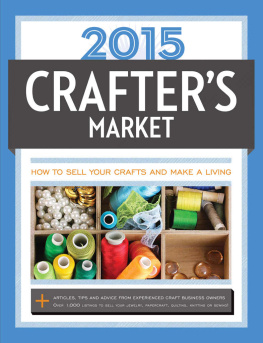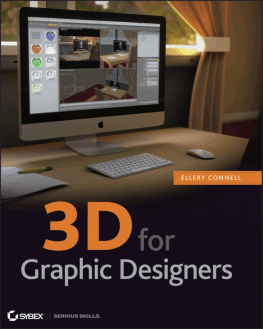40TH ANNUAL EDITION
2015
ARTISTS &
GRAPHIC DESIGNERS
MARKET
HOW TO SELL YOUR ART AND MAKE A LIVING
Mary Burzlaff Bostic, Editor

Cincinnati, Ohio
artistsmarketonline.com
CONTENTS

John Howe

Tomie dePaola

Mikey Burton
FROM THE EDITOR

Its an exciting time to be a creative. On one hand, its never been easier to start your art or design business. The Internet allows creatives to network, learn new skills, find customers, and market their wares with just a click of a mouse. On the other hand, it also means that the competition has never been fiercer. How can you make your art or design business stand out from the pack?
As always, Artists & Graphic Designers Market is here to help! We have a great lineup of articles to help you build your business and refine your skills, interviews with inspiring professionals, and, of course, more than 1,700 market listings with contact info and submission details to help you find new customers.
Whats holding you back? Read on, keep creating and good luck!

Mary Burzlaff Bostic
www.artistsmarketonline.com
BUSINESS BASICS
HOW TO USE THIS BOOK
If youre picking up this book for the first time, you might not know quite how to start using it. Your first impulse might be to flip through and quickly make a mailing list, submitting to everyone with hopes that someone might like your work. Resist that urge. First you have to narrow down the names in this book to those who need your particular art style. Thats what this book is all about. We provide the names and addresses of art buyers along with plenty of marketing tips. You provide the hard work, creativity, and patience necessary to hang in there until work starts coming your way.
Listings
The book is divided into market sections, from galleries to art fairs. (See the Table of Contents for a complete list.) Each section begins with an introduction containing information and advice to help you break into that specific market. Listings are the meat of this book. In a nutshell, listings are names, addresses, and contact information for places that buy or commission artwork, along with a description of the type of art they need and their submission preferences.
Articles and Interviews
Throughout this book you will find helpful articles and interviews with working artists and experts from the art world. These articles give you a richer understanding of the marketplace by sharing the featured artists personal experiences and insights. Their stories, and the lessons you can learn from other artists feats and follies, give you an important edge over competition.
HOW ARTISTS & GRAPHIC DESIGNERS MARKET WORKS
Following the instructions in the listings, we suggest you send samples of your work (not originals) to a dozen (or more) targeted markets. The more companies you send to, the greater your chances of a positive response. Establish a system to keep track of whom you submit your work to and send follow-up mailings to your target markets at least twice a year.
How to Read Listings
The first thing youll notice about many of the listings in this book is the group of symbols that appears before the name of each company. (Youll find a quick-reference key to the symbols on the back inside cover of the book.) Heres what each symbol stands for:
 Market new to this edition
Market new to this edition
 Canadian market
Canadian market
 International market
International market
 Market prefers to work with local artists/designers
Market prefers to work with local artists/designers
Each listing contains a description of the artwork and/or services the company prefers. The information often reveals how much freelance artwork is used, whether computer skills are needed, and which software programs are preferred.
In some sections, additional subheads help you identify potential markets. Magazine listings specify needs for cartoons and illustrations. Galleries specify media and style.
Editorial comments, denoted by  , give you extra information about markets, such as company awards, mergers and insight into a companys staff or procedures.
, give you extra information about markets, such as company awards, mergers and insight into a companys staff or procedures.
It might take a while to get accustomed to the layout and language in the listings. In the beginning, you will encounter some terms and symbols that might be unfamiliar to you. Refer to the Glossary to help you with terms you dont understand.
Working With Listings
1. Read the entire listing to decide whether to submit your samples. Do not use this book simply as a mailing list of names and addresses. Reading listings carefully helps you narrow your mailing list and submit appropriate material.
2. Read the description of the company or gallery in the first paragraph of the listing. Then jump to the Needs or Media heading to find out what type of artwork is preferred. Is it the type of artwork you create? This is the first step to narrowing your target market. You should send your samples only to places that need the kind of work you create.
3. Send appropriate submissions. It seems like common sense to research what kind of samples a listing wants before sending off just any artwork you have on hand. But believe it or not, some artists skip this step. Some art directors have pulled their listings from Artists & Graphic Designers Market because theyve received too many inappropriate submissions. Look under the First Contact & Terms heading to find out how to contact the market and what to send. Some companies and publishers are very picky about what kinds of samples they like to see; others are more flexible.
FREQUENTLY ASKED QUESTIONS
1How do companies get listed in the book? No company pays to be includedall listings are free. Every company has to fill out a detailed questionnaire about their art needs. All questionnaires are screened to make sure the companies meet our requirements. Each year we contact every company in the book and ask them to update their information.
2Why arent other companies I know about listed in this book? We may have sent these companies a questionnaire, but they never returned it. Or if they did return a questionnaire, we may have decided not to include them based on our requirements. If you know of a market youd like to see in the book, send an e-mail request to .





















 Market new to this edition
Market new to this edition Canadian market
Canadian market International market
International market Market prefers to work with local artists/designers
Market prefers to work with local artists/designers , give you extra information about markets, such as company awards, mergers and insight into a companys staff or procedures.
, give you extra information about markets, such as company awards, mergers and insight into a companys staff or procedures.